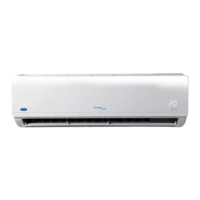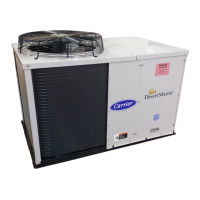Do you have a question about the Carrier 50LC 12 and is the answer not in the manual?
Important precautions for installation and servicing of HVAC equipment.
Warning about the dangers of electrical shock during service operations.
Details on navigating and using the SystemVu controller's interface.
Explains the SystemVu control system and its interface for unit management.
Instructions for operating the hand-held Navigator accessory display.
Steps for preparing the unit, checking electrical connections, and power supply.
Guidance on initial unit startup, network setup, and logging configuration changes.
Configuration steps for network settings and communication protocols.
Common configurations for accessories and controls during startup.
Procedure for enabling and executing the System Auto Test.
Setting up occupancy schedules with eight distinct periods and day configurations.
How thermostats and unit control types manage cooling and heating stages.
Control logic for Humidi-MiZer system using humidistat or humidity sensor inputs.
Key parameters for configuring factory options and field accessories.
Configuring startup delay, unit control type, and thermostat type.
How the control determines unit demand based on various factors and priorities.
Defining cooling and heating demand based on temperature differences and trends.
Mapping thermostat inputs to system demand levels for cooling and heating.
How effective setpoints are determined based on occupancy and slider adjustments.
Determining system demand based on space temperature and setpoints.
Using return air temperature for demand determination.
Factors affecting occupancy and their priority levels for unit operation.
Logic for demanding dehumidification based on humidistat or humidity sensor inputs.
Explanation of the Staged Air Volume (SAV) method for supply fan speed control using VFDs.
Overview of different cooling sub-modes and entry conditions.
How the system determines and requests cooling stages based on demand and trends.
Control logic for outdoor fans, including multi-speed motors and low ambient operation.
Information on the Humidi-MiZer system's improved dehumidification modes.
Determining dehumidification demand based on humidistat or humidity sensor inputs.
Available modes for Humidi-MiZer units: Dehumidification and Dehum/Mech Cooling.
Unit operation in normal cooling mode versus dehumidification-only mode.
Improved dehumidification using fan-based methods (Max Comfort, Max Dehum).
Overview of heating modes: HEATING, HEATING PREVENTED, SHUTTING HEAT OFF.
Determining and requesting heating stages based on demand and unit resources.
Staging control that uses stage timers and supply air trend for heating.
Staging control that directly follows thermostat inputs for heating.
Responsibility for energizing or de-energizing heat stage relays based on staging control.
Control logic for gas heat module start-up, monitoring safety switches.
Enabling and configuring the economizer for ventilation and cooling.
Economizer damper position logic for maintaining constant airflow during ventilation.
Conditions that trigger dry bulb lockout, disabling free cooling.
Conditions that trigger enthalpy lockout, disabling free cooling.
Conditions that trigger lockout during unoccupied periods, disabling free cooling.
Function of power exhaust to assist building exhaust air, controlled by relays.
Algorithm to calculate bias time for optimal start, used for ASHRAE 90.1 compliance.
Configuring the SystemVu controller for BACnet communication.
Understanding system alerts and faults, indicated by status lights and terminal outputs.
Troubleshooting specific alarm codes, their causes, and actions.
Troubleshooting communication issues by measuring resistance on control boards.
Procedure for field-configuring a replacement controller for Humidi-MiZer system option.
Service analysis for gas heating issues, checking IGC board and alarm codes.
Service analysis for electric heating issues.
Layout of the Run Status menu, detailing items, expansion, range, units, and points.
Continuation of the Run Status menu layout, covering COOL, HEAT, VENTILATION, and INDOOR FAN sections.
Layout of the Settings menu, covering SPACE SET POINTS and TEMP DEMAND CONFIG.
Continuation of Settings menu layout, covering QUICK SETUP CONFIG.
Layout of the Service menu, including UNIT TESTS and FAN TESTS.
Continuation of Service menu layout, covering HARDWARE INPUTS and CALIBRATION.
Layout of the Inputs menu, covering TEMPERATURES, PRESSURES, THERMOSTAT, and SWITCH INPUTS.
Continuation of Inputs menu layout, covering ANALOG INPUTS and GENERAL INPUTS.
Layout of the Outputs menu, covering GENERAL OUTPUTS, COOLING OUTPUTS, and HEATING OUTPUTS.
Layout for viewing and resetting active alerts and faults.
Display of operating modes including COOL, HEAT, VENT, and TEST.
Display menu for accessing various service test functions for unit components.
Display of input status for thermostats, switches, analog sensors, and network values.
Display of setpoints for cooling, heating, and humidity, including offsets and gaps.
Display of configuration settings for General Unit, DI Config, and Analog Input.
Continuation of Configuration settings for HEATING, INDOOR FAN, and VFD parameters.
Tables for configuring network settings like BAS Protocol Select and BACnet parameters.
CCN table detailing operating modes like COOL, HEAT, VENT, and TEST.
Maintenance tables for VENTCURV, IAQODIAG, andECON_CFG.
Continuation of Service Config tables for ZSENSCFG, TOUCHCFG, and TRIM.
CCN table listing active alarms, history, and reset functions.
Tables for service configurations including UNIT_CFG, DMD_CFG, and COOL_CFG.
Pre-startup verification steps for packaging, installation, electrical, and gas systems.
Sequential steps for starting the Humidi-MiZer system in cooling and dehumidification modes.
Important precautions for installation and servicing of HVAC equipment.
Warning about the dangers of electrical shock during service operations.
Details on navigating and using the SystemVu controller's interface.
Explains the SystemVu control system and its interface for unit management.
Instructions for operating the hand-held Navigator accessory display.
Steps for preparing the unit, checking electrical connections, and power supply.
Guidance on initial unit startup, network setup, and logging configuration changes.
Configuration steps for network settings and communication protocols.
Common configurations for accessories and controls during startup.
Procedure for enabling and executing the System Auto Test.
Setting up occupancy schedules with eight distinct periods and day configurations.
How thermostats and unit control types manage cooling and heating stages.
Control logic for Humidi-MiZer system using humidistat or humidity sensor inputs.
Key parameters for configuring factory options and field accessories.
Configuring startup delay, unit control type, and thermostat type.
How the control determines unit demand based on various factors and priorities.
Defining cooling and heating demand based on temperature differences and trends.
Mapping thermostat inputs to system demand levels for cooling and heating.
How effective setpoints are determined based on occupancy and slider adjustments.
Determining system demand based on space temperature and setpoints.
Using return air temperature for demand determination.
Factors affecting occupancy and their priority levels for unit operation.
Logic for demanding dehumidification based on humidistat or humidity sensor inputs.
Explanation of the Staged Air Volume (SAV) method for supply fan speed control using VFDs.
Overview of different cooling sub-modes and entry conditions.
How the system determines and requests cooling stages based on demand and trends.
Control logic for outdoor fans, including multi-speed motors and low ambient operation.
Information on the Humidi-MiZer system's improved dehumidification modes.
Determining dehumidification demand based on humidistat or humidity sensor inputs.
Available modes for Humidi-MiZer units: Dehumidification and Dehum/Mech Cooling.
Unit operation in normal cooling mode versus dehumidification-only mode.
Improved dehumidification using fan-based methods (Max Comfort, Max Dehum).
Overview of heating modes: HEATING, HEATING PREVENTED, SHUTTING HEAT OFF.
Determining and requesting heating stages based on demand and unit resources.
Staging control that uses stage timers and supply air trend for heating.
Staging control that directly follows thermostat inputs for heating.
Responsibility for energizing or de-energizing heat stage relays based on staging control.
Control logic for gas heat module start-up, monitoring safety switches.
Enabling and configuring the economizer for ventilation and cooling.
Economizer damper position logic for maintaining constant airflow during ventilation.
Conditions that trigger dry bulb lockout, disabling free cooling.
Conditions that trigger enthalpy lockout, disabling free cooling.
Conditions that trigger lockout during unoccupied periods, disabling free cooling.
Function of power exhaust to assist building exhaust air, controlled by relays.
Algorithm to calculate bias time for optimal start, used for ASHRAE 90.1 compliance.
Configuring the SystemVu controller for BACnet communication.
Understanding system alerts and faults, indicated by status lights and terminal outputs.
Troubleshooting specific alarm codes, their causes, and actions.
Troubleshooting communication issues by measuring resistance on control boards.
Procedure for field-configuring a replacement controller for Humidi-MiZer system option.
Service analysis for gas heating issues, checking IGC board and alarm codes.
Service analysis for electric heating issues.
Layout of the Run Status menu, detailing items, expansion, range, units, and points.
Continuation of the Run Status menu layout, covering COOL, HEAT, VENTILATION, and INDOOR FAN sections.
Layout of the Settings menu, covering SPACE SET POINTS and TEMP DEMAND CONFIG.
Continuation of Settings menu layout, covering QUICK SETUP CONFIG.
Layout of the Service menu, including UNIT TESTS and FAN TESTS.
Continuation of Service menu layout, covering HARDWARE INPUTS and CALIBRATION.
Layout of the Inputs menu, covering TEMPERATURES, PRESSURES, THERMOSTAT, and SWITCH INPUTS.
Continuation of Inputs menu layout, covering ANALOG INPUTS and GENERAL INPUTS.
Layout of the Outputs menu, covering GENERAL OUTPUTS, COOLING OUTPUTS, and HEATING OUTPUTS.
Layout for viewing and resetting active alerts and faults.
Display of operating modes including COOL, HEAT, VENT, and TEST.
Display menu for accessing various service test functions for unit components.
Display of input status for thermostats, switches, analog sensors, and network values.
Display of setpoints for cooling, heating, and humidity, including offsets and gaps.
Display of configuration settings for General Unit, DI Config, and Analog Input.
Continuation of Configuration settings for HEATING, INDOOR FAN, and VFD parameters.
Tables for configuring network settings like BAS Protocol Select and BACnet parameters.
CCN table detailing operating modes like COOL, HEAT, VENT, and TEST.
Maintenance tables for VENTCURV, IAQODIAG, andECON_CFG.
Continuation of Service Config tables for ZSENSCFG, TOUCHCFG, and TRIM.
CCN table listing active alarms, history, and reset functions.
Tables for service configurations including UNIT_CFG, DMD_CFG, and COOL_CFG.
Pre-startup verification steps for packaging, installation, electrical, and gas systems.
Sequential steps for starting the Humidi-MiZer system in cooling and dehumidification modes.
| Net Weight (Outdoor Unit) | 32 kg |
|---|---|
| Type | Split Type |
| Cooling Capacity | 12000 BTU/h |
| Power Supply | 220-240V, 50Hz |
| Refrigerant | R410A |












